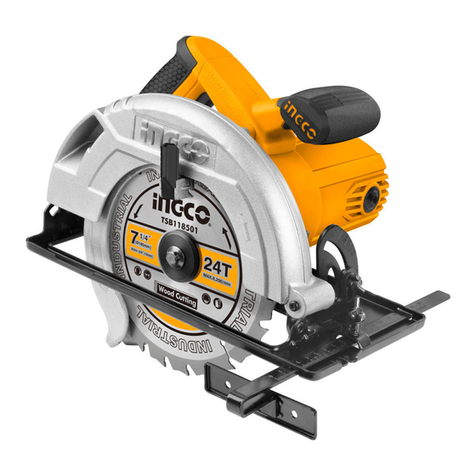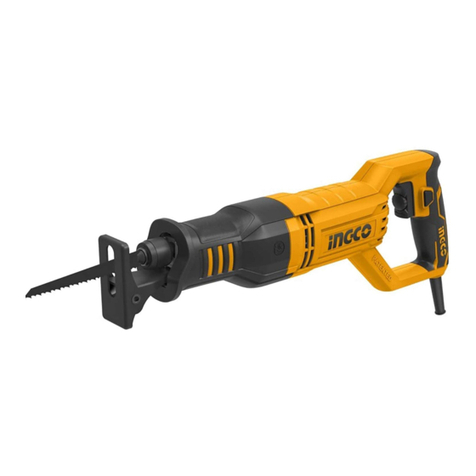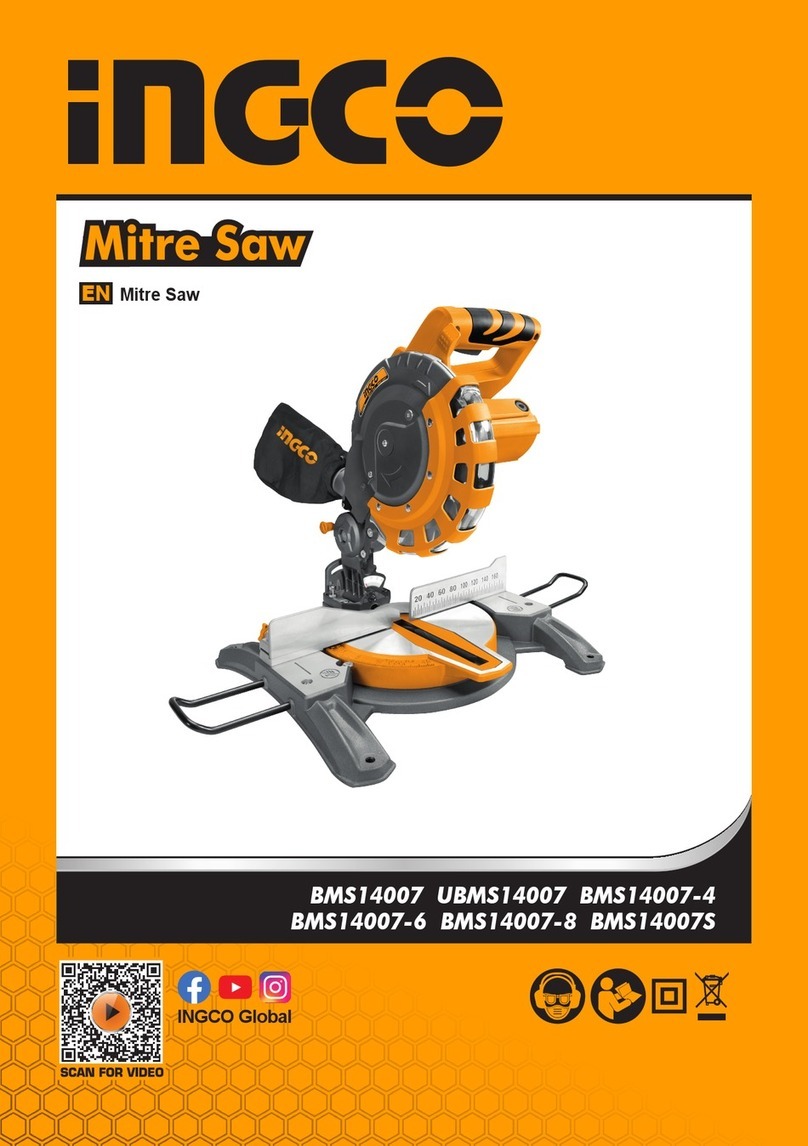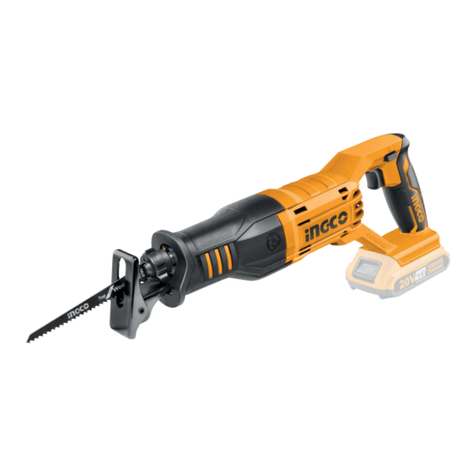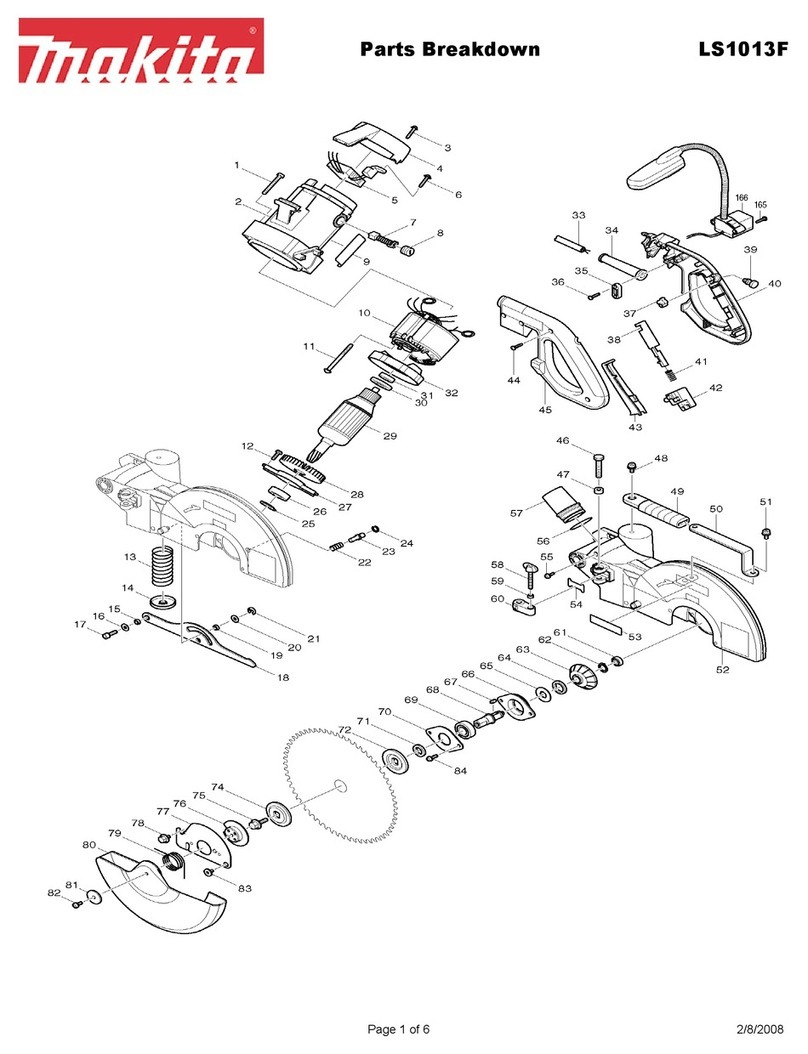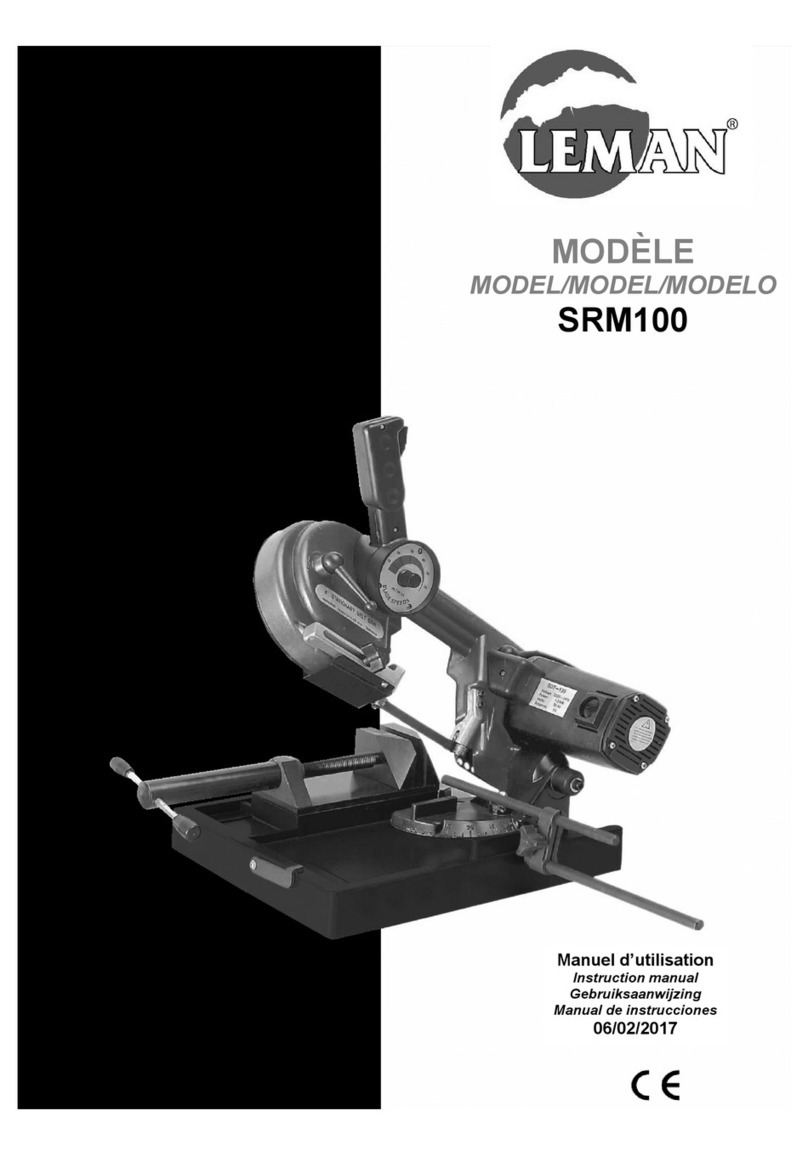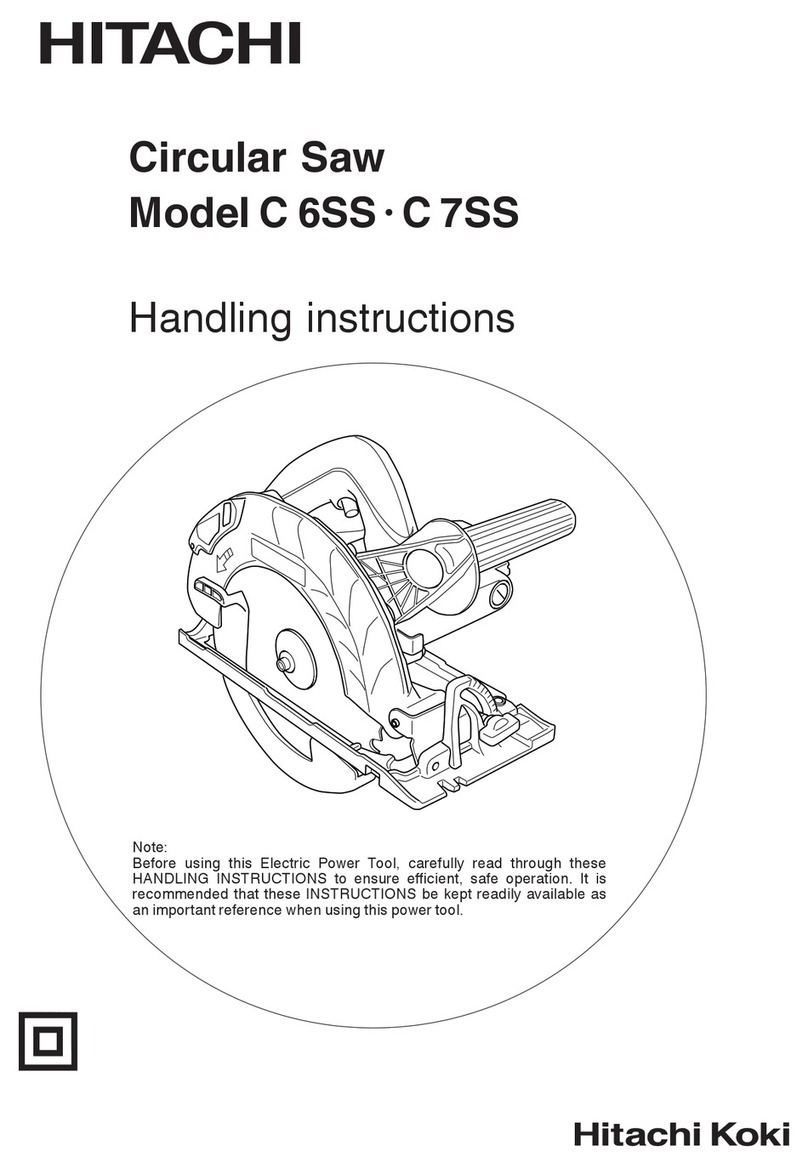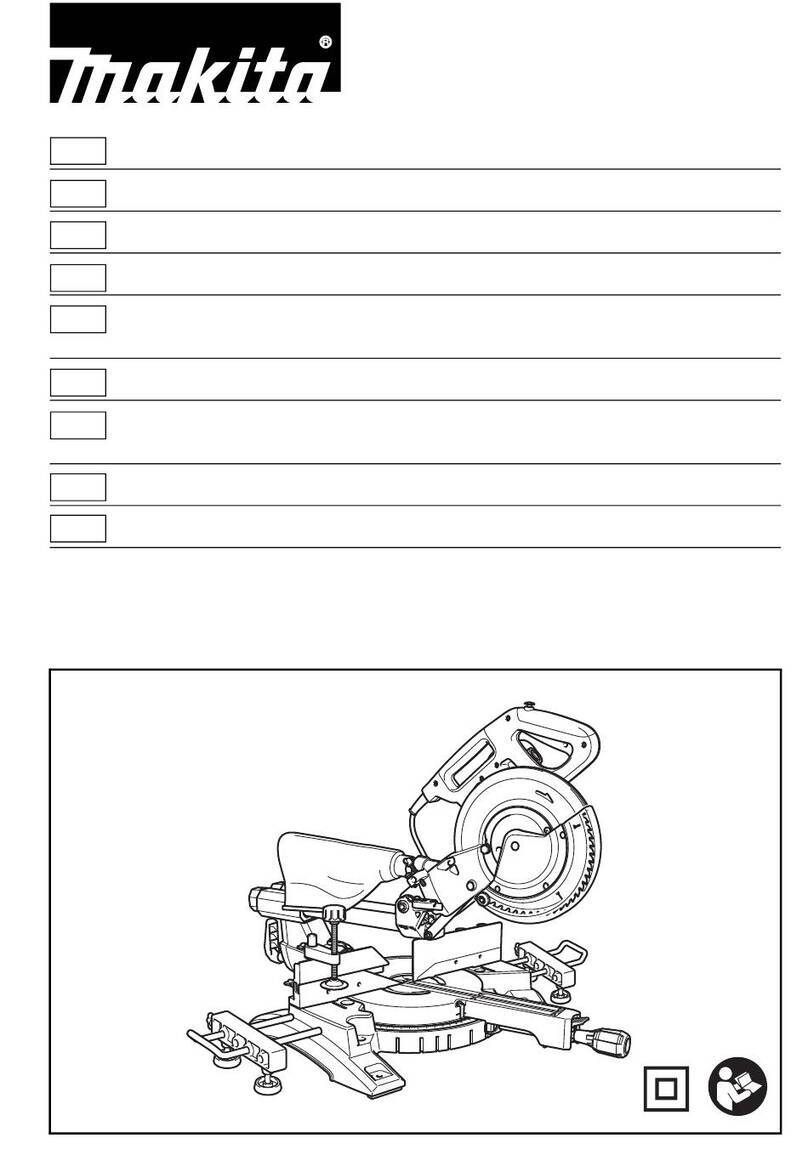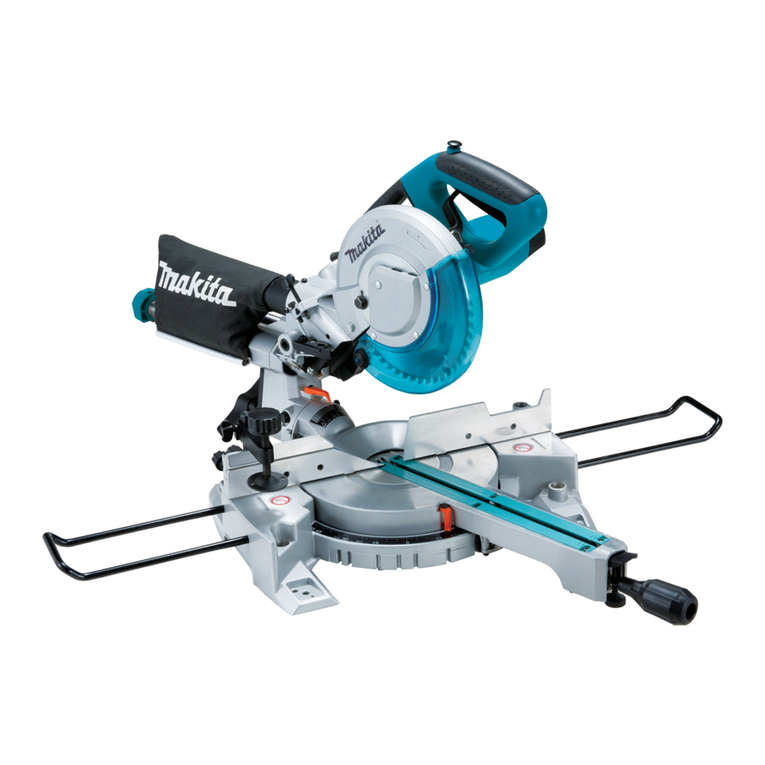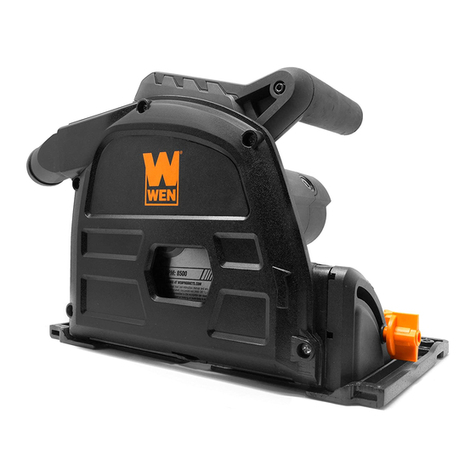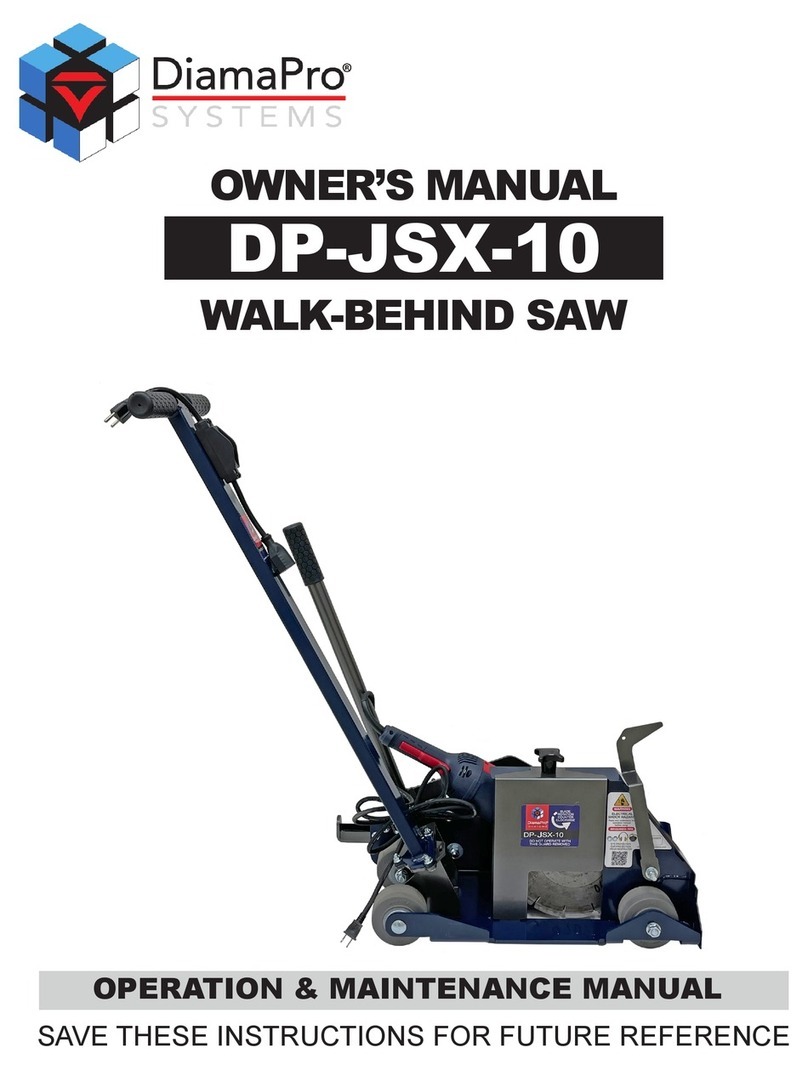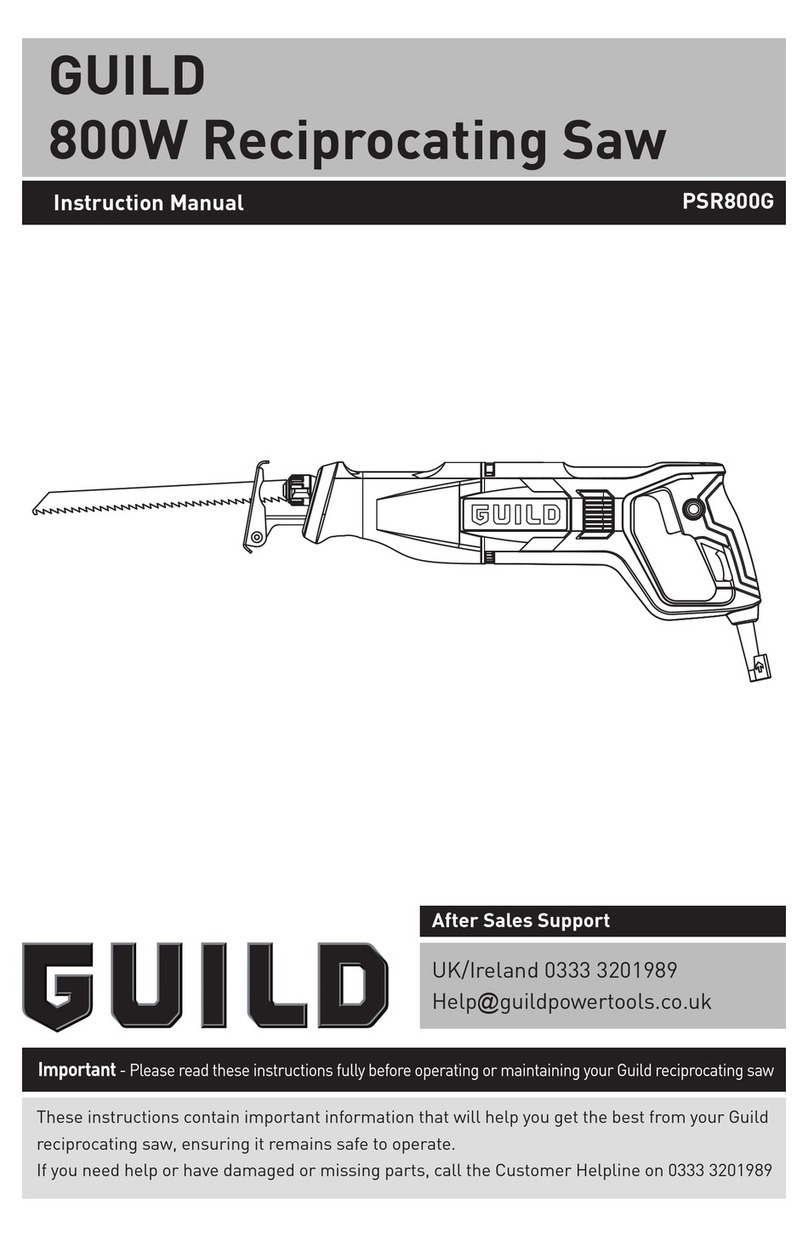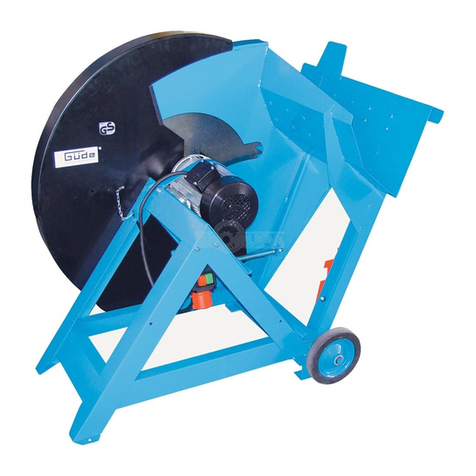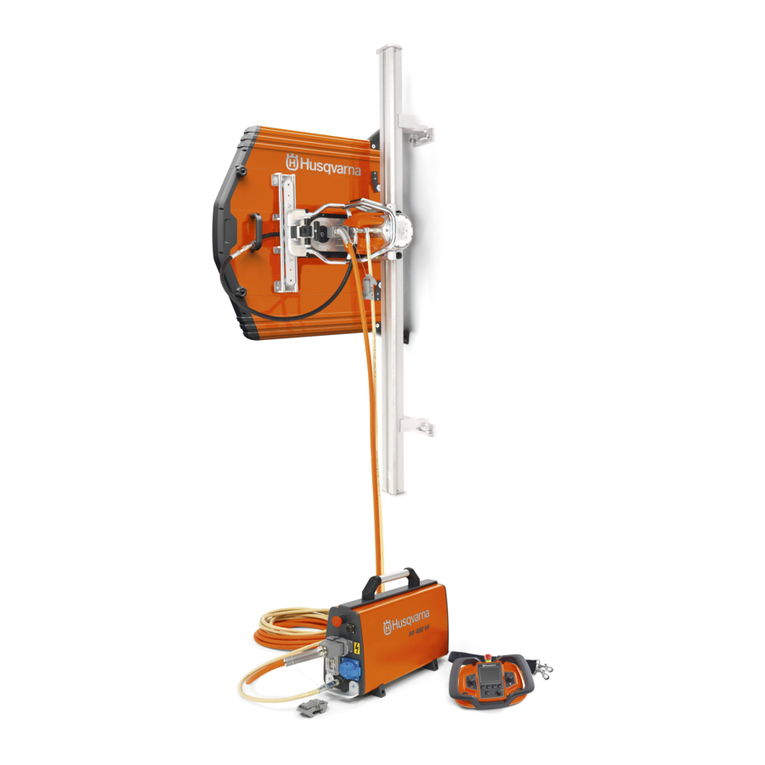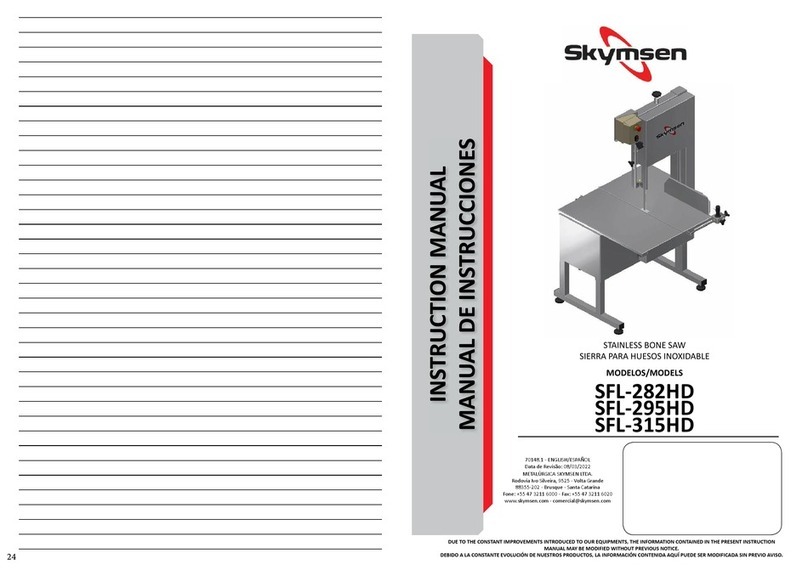Ingco CSLI1401 User manual

Lithium-Ion Circular Saw
EN
CSLI1401
Lithium-Ion Circular Saw
6
ingcoglobal
INGCO GLOBAL
Lithium-Ion Circular Saw

ENGLISH (Original instructions)
SPECIFICATIONS
Bl
Model
ade diameter 140 mm
CSLI1401
at 90°
at 45°
40 mm
28 mm
Max. Cutting depth
No load speed (RPM) 3,600 /min
Rated voltage 20V
Standard battery cartridges FBLI2001 FBLI2002
• Due to our continuing program of research and development, the specifications herein are subject to change without notice.
• Specifications and battery cartridge may differ from country tocountry.
General Power Tool Safety
Warnings
WARNING Read all safety warnings and all
instructions. Failure to follow the warnings and
instructions may result in electric shock, fire and/or
serious injury.
Save all warnings and
instructions for future reference.
The term "power tool" in the warnings refers to your
mains-operated (corded) power tool or battery-operated
(cordless) power tool.
Work area safety
1. Keep work area clean and well lit. Cluttered or
dark areas invite accidents.
2. Do not operate power tools in explosive
atmospheres, such as in the presence of
flammable liquids, gases or dust. Power tools
create sparks which may ignite the dust or fumes.
3. Keep children and bystanders away while
operating a power tool. Distractions can cause
you to lose control.
Electrical Safety
4. Power tool plugs must match the outlet. Never
modify the plug in any way. Do not use any
adapter plugs with earthed (grounded) power
tools. Unmodified plugs and matching outlets will
reduce risk of electric shock.
5. Avoid body contact with earthed or grounded
surfaces such as pipes, radiators, ranges and
refrigerators. There is an increased risk of
electric shock if your body is earthed or grounded.
6. Do not expose power tools to rain or wet
conditions. Water entering a power tool will
increase the risk of electric shock.
7. Do not abuse the cord. Never use the cord for
carrying, pulling or unplugging the power tool.
Keep cord away from heat, oil, sharp edges or
moving parts. Damaged or entangled cords
increase the risk of electric shock.
8. When operating a power tool outdoors, use an
extension cord suitable for outdoor use. Use
of a cord suitable for outdoor use reduces the risk
of electric shock.
9. If operating a power tool in a damplocation is
unavoidable, use a ground fault circuit
interrupter (GFCI) protected supply. Use of an
GFCI reduces the risk of electric shock.
Personal Safety
10. Stay alert, watch what you are doing and use
common sense when operating a power tool.
Do not use a power tool while you are tired or
under the influence of drugs, alcohol or
medication. A moment of inattention while
operating power tools may result in serious
personal injury.
11. Use personal protective equipment. Always
wear eye protection. Protective equipment such
as dust mask, non-skid safety shoes, hard hat, or
hearing protection used for appropriate conditions
will reduce personal injuries.
12. Prevent unintentional starting. Ensure the
switch is in the off-position before connecting
to power source and/or battery pack, picking
up or carrying the tool. Carrying power tools
with your finger on the switch or energising power
tools that have the switch on invites accidents.
13. Remove any adjusting key or wrench before
turning the power tool on. A wrench or a key
left attached to a rotating part of the power tool
may result in personal injury.
2|English

14.Do not overreach. Keep proper footing and
balance at all times. This enables better control
of the power tool in unexpected situations.
15.Dress properly. Do not wear loose clothing or
jewellery. Keep your hair, clothing, and gloves
away from moving parts. Loose clothes,
jewellery or long hair can be caught in moving
parts.
16.If devices are provided for the connection of
dust extraction and collection facilities,
ensure these are connected and properly
used.Use of dust collection can reduce dust-
related hazards.
Power tool use and care
17.Do not force the power tool. Use the correct
power tool for your application. The correct
power tool will do the job better and safer at the
rate for which it was designed.
18.Do not use the power tool if the switch does
not turn it on and off.Any power tool that
cannot be controlled with the switch is dangerous
and must be repaired.
19.Disconnect the plug from the power source
and/or the battery pack from the power tool
before making any adjustments, changing
accessories, or storing power tools.Such
preventive safety measures reduce the risk of
starting the power tool accidentally.
20.Store idle power tools out of the reach of
children and do not allow persons unfamiliar
with the power tool or these instructions to
operate the power tool. Power tools are
dangerous in the hands of untrained users.
21.Maintain power tools. Check for misalignment
or binding of moving parts, breakage of parts
and any other condition that may affect the
power tool’s operation. If damaged, have the
power tool repaired before use.Many
accidents are caused by poorly maintained power
tools.
22.Keep cutting tools sharp and clean. Properly
maintained cutting tools with sharp cutting edges
are less likely to bind and are easier to control.
23.Use the power tool, accessories and tool bits
etc. in accordance with these instructions,
taking into account the working conditions
and the work to be performed.Use of the
power tool for operations different from those
intended could result in a hazardous situation.
Battery tool use and care
24.Recharge only with the charger specified by
the manufacturer. A charger that is suitable for
one type of battery pack may create a risk of fire
when used with another battery pack.
25.Use power tools only with specifically
designated battery packs.Use of any other
battery packs may create a risk of injury and fire.
26.When battery pack is not in use, keep it away
from other metal objects, like paper clips,
coins, keys, nails, screws or other small metal
objects, that can make a connection from one
terminal to another. Shorting the battery
terminals together may cause burns or a fire.
27.Under abusive conditions, liquid may be
ejected from the battery; avoid contact. If
contact accidentally occurs, flush with water.
If liquid contacts eyes, additionally seek
medical help. Liquid ejected from the battery
may cause irritation or burns.
Service
28.Have your power tool serviced by a qualified
repair person using only identical
replacement parts. This will ensure that the
safety of the power tool is maintained.
29.Follow instruction for lubricating and
changing accessories.
30.Keep handles dry, clean and free from oil and
grease.
CORDLESS CIRCULAR SAW
SAFETY WARNINGS
Cutting procedures
1. DANGER: Keep hands away from cutting
area and the blade. Keep your second hand
on auxiliary handle, or motor housing.If both
hands are holding the saw, they cannot be cut by
the blade.
2. Do not reach underneath the workpiece.The
guard cannot protect you from the blade below
the workpiece.
3. Adjust the cutting depth to the thickness of
the workpiece. Less than a full tooth of the blade
teeth should be visible below the workpiece.
4. Never hold piece being cut in your hands or
across your leg. Secure the workpiece to a
stable platform. It is important to support the
work properly to minimize body exposure, blade
binding, or loss of control.
3|English

A typical illustration of proper hand support
and workpiece support.
5. Hold the power tool by insulated gripping
surfaces only, when performing an operation
where the cutting tool may contact hidden
wiring.Contact with a "live" wire will also make
exposed metal parts of the power tool "live" and
could give the operator an electric shock.
6. When ripping, always use a rip fence or
straight edge guide. This improves the accuracy
of cut and reduces the chance of blade binding.
7. Always use blades with correct size and
shape (diamond versus round) of arbour
holes.Blades that do not match the mounting
hardware of the saw will run eccentrically,
causing loss of control.
8. Never use damaged or incorrect blade
washers or bolt. The blade washers and bolt
were specially designed for your saw, for
optimum performance and safety of operation.
Kickback causes and related warnings
kickback is a sudden reaction to a pinched, bound
or misaligned saw blade, causing an uncontrolled
saw to lift up and out of the workpiece toward the
operator;
when the blade is pinched or bound tightly by the
kerf closing down, the blade stalls and the motor
reaction drives the unit rapidly back toward the
operator;
if the blade becomes twisted or misaligned in the cut,
the teeth at the back edge of the blade can dig into the
top surface of the wood causing the blade to climb out
of the kerf and jump back toward the operator.
Kickback is the result of saw misuse and/or incorrect
operating procedures or conditions and can be avoided
by taking proper precautions as given below.
9. Maintain a firm grip with both hands on the
saw and position your arms to resist kickback
forces. Position your body to either side of
the blade, but not in line with the blade.
Kickback could cause the saw to jump backwards,
but kickback forces can be controlled by the
operator, if proper precautions are taken.
10.When blade is binding, or when interrupting a
cut for any reason, release the trigger and
hold the saw motionless in the material until
the blade comes to a complete stop. Never
attempt to remove the saw from the work or
pull the saw backward while the blade is in
motion or kickback may occur. Investigate and
take corrective actions to eliminate the cause of
blade binding.
11. When restarting a saw in the workpiece,
centre the saw blade in the kerf and check
that saw teeth are not engaged into the
material. If saw blade is binding, it may walk up
or kickback from the workpiece as the saw is
restarted.
12.
Support large panels to minimise the risk of
blade pinching and kickback.
Large panels tend
to sag under their own weight. Supports must be
placed under the panel on both sides, near the line
of cut and near the edge of the panel.
To avoid kickback, do support
board or panelnear the cut.
Do not support board or
panel away from the cut.
13.Do not use dull or damaged blades.
Unsharpened or improperly set blades produce
narrow kerf causing excessive friction, blade
binding and kickback.
14.Blade depth and bevel adjusting locking
levers must be tight and secure before
making cut.If blade adjustment shifts while
cutting, it may cause binding and kickback.
4|English

15.Use extra caution when sawing into existing
walls or other blind areas. The protruding blade
may cut objects that can cause kickback.
16.ALWAYS hold the tool firmly with both hands.
NEVER place your hand or fingers behind the
saw.If kickback occurs, the saw could easily
jump backwards over your hand, leading to
serious personal injury.
17.Never force the saw. Push the saw forward at
a speed so that the blade cuts without
slowing.Forcing the saw can cause uneven cuts,
loss of accuracy, and possible kickback.
Lower guard function
18.Check lower guard for proper closing before
each use. Do not operate the saw if lower
guard does not move freely and close
instantly. Never clamp or tie the lower guard
into the open position. If saw is accidentally
dropped, lower guard may be bent. Raise the
lower guard with the retracting handle and make
sure it moves freely and does not touch the blade
or any other part, in all angles and depths of cut.
19.Check the operation of the lower guard spring.
If the guard and the spring are not operating
properly, they must be serviced before use.
Lower guard may operate sluggishly due to
damaged parts, gummy deposits, or a build-up of
debris.
20.Lower guard should be retracted manually
only for special cuts such as "plunge cuts"
and "compound cuts". Raise lower guard by
retracting handle and as soon as blade enters
the material, the lower guard must be released.
For all other sawing, the lower guard should
operate automatically.
21.
Always observe that the lower guard is
covering the blade before placing saw down on
bench or floor.
An unprotected, coasting blade will
cause the saw to walk backwards, cutting whatever
is in its path. Be aware of the time it takes for the
blade to stop after switch is released.
22.To check lower guard, open lower guard by
hand, then release and watch guard closure.
Also check to see that retracting handle does
not touch tool housing.Leaving blade exposed
is VERY DANGEROUS and can lead to serious
personal injury.
Additional safety warnings
23.Intended use
This tool is intended to cut wood products
only. Accumulated sawdust on the lower guard
and hub from other materials may effect the
proper closure of the lower guard which could
lead to serious personal injury.
24.Use extra caution when cutting damp wood,
pressure treated lumber, or wood containing
knots. Maintain smooth advancement of tool
without decrease in blade speed to avoid
overheating the blade tips.
25.Do not attempt to remove cut material when
blade is moving. Wait until blade stops before
grasping cut material.Blades coast after turn off.
26.Avoid Cutting Nails. Inspect for and remove
all nails from lumber before cutting.
27.Place the wider portion of the saw base on
that part of the workpiece which is solidly
supported, not on the section that will fall off
when the cut is made. As examples, Fig. 1
illustrates the RIGHT way to cut off the end of
a board, and Fig. 2 the WRONG way. If the
workpiece is short or small, clamp it down.
DO NOT TRY TO HOLD SHORT PIECES BY
HAND!
Fig.1
5|English

Fig.2
28.Before setting the tool down after completing
a cut, be sure that the lower guard has closed
and the blade has come to a complete stop.
29.Never attempt to saw with the circular saw
held upside down in a vise. This is extremely
dangerous and can lead to serious accidents.
30.Some material contains chemicals which may
be toxic. Take caution to prevent dust
inhalation and skin contact. Follow material
supplier safety data.
31.Do not stop the blades by lateral pressure on
the saw blade.
32.Do not use any abrasive wheels.
33.
Only use the saw blade with the diameter that is
marked on the tool or specified in the manual.
Use of an incorrectly sized blade may affect the
proper guarding of the blade or guard operation
which couldresultinseriouspersonal injury.
34.Keep blade sharp and clean. Gum and wood
pitch hardened on blades slows saw and
increases potential for kickback. Keep blade
clean by first removing it from tool, then cleaning
it with gum and pitch remover, hot water or
kerosene. Never use gasoline.
35.Wear a dust mask and hearing protection
when use the tool.
SAVE THESE INSTRUCTIONS.
WARNING:
DO NOT let comfort or familiarity with product
(gained from repeated use) replace strict adherence
to safety rules for the subject product. MISUSE or
failure to follow the safety rules stated in this
instruction manual may cause serious personal
injury.
Symbols
The followings show the symbols used for tool.
volts
direct current
no load speed
revolutions or reciprocation per minute
6|English

1
2
Adjusting depth of cut
1
CAUTION:
•After adjusting the depth of cut, always tighten the
lever securely.
Loosen the lever on the side of the rear handle and
move the base up or down. At the desired depth of cut,
secure the base by tightening the lever.
For cleaner, safer cuts, set cut depth so that no more
than one blade tooth projects below workpiece. Using
proper cut depth helps to reduce potential for dangerous
KICKBACKS which can cause personal injury.
Bevel cutting
1
Loosen the lever on the bebel scale plate on the front
base. Set for the desired angle (0° - 50°) by tilting
accordingly, then tighten the lever securely.
Sighting
1
2
AB
For straight cuts, align the A position on the front of the
base with your cutting line. For 45° bevel cuts, align the
B position with it.
Switch action
CAUTION:
•Before inserting the battery cartridge into the tool,
always check to see that the switch trigger
actuates properly and returns to the "OFF"
position when released.
•Do not pull the switch trigger hard without pressing
the lock-off lever. This can cause switch breakage.
To prevent the switch trigger from being accidentally
pulled, a lock-off lever is provided. To start the tool,
press the lock-off lever and pull the switch trigger.
Release the switch trigger to stop.
WARNING:
•For your safety, this tool is equipped with lock-off
lever which prevents the tool from unintended
1. Lock-off lever
2. Switch trigger
1. Base
2. Cutting line
1. Lever
1. Lever
7|English

starting. NEVER use the tool if it runs when you
simply pull the switch trigger without pressing the
lock-off lever. Return tool a INGCO service center
for proper repairs BEFORE further usage.
•NEVER tape down or defeat purpose and function
of lock-off lever.
Electric brake
This tool is equipped with an electric blade brake. If the
tool consistently fails to quickly stop blade after switch
trigger release, have tool serviced at a INGCO service
center.
The blade brake system is not a substitute for lower
guard. NEVER USE TOOL WITHOUT A FUNCTIONING
LOWER GUARD. SERIOUS PERSONAL INJURY CAN
RESULT.
Lighting the lamp
CAUTION:
•Do not look in the light or see the source of light
directly.
Only to turn on the light, pull the switch trigger without
pressing the lock-off lever. To turn on the light and run
the tool, press the lock-off lever and pull the switch
trigger with the lock-off lever being pressed.
NOTE:
•Use a cotton stick to wipe the dirt off the lens of
lamp. Be careful not to scratch the lens of lamp, or
it may lower the illumination.
•Do not use gasoline, thinner or the like to clean
the lens of lamp. Using such substances will
damage the lens.
ASSEMBLY
CAUTION:
•Always be sure that the tool is switched off and the
battery cartridge is removed before carrying out
any work on the tool.
Removing or installing blade
1
CAUTION:
•Be sure the blade is installed with teeth pointing
up at the front of the tool.
•Use only the INGCO wrench to install or remove
the blade.
To remove the blade, press the shaft lock so that the
blade cannot revolve and use the wrench to loosen the
hex bolt counterclockwise. Then remove the hex bolt,
outer flange and blade.
To install the blade, follow the removal procedure in
reverse. BE SURE TO TIGHTEN THE HEX BOLT
CLOCKWISE SECURELY.
When changing blade, make sure to also clean upper
and lower blade guards of accumulated chips and
particles. Such efforts do not, however, replace the
need to check lower guard operation before each use.
Hex wrench storage
When not in use, store the hex wrench as shown in the
figure to keep it from being lost.
1. Hex wrench
1. Hex bolt
2. Outer flange
3. Saw blade
4. Inner flange
1. Hex wrench
1. Shaft lock
8|English
1
1
2
3
4

OPERATION
CAUTION:
•Always insert the battery cartridge all the way until
it locks in place. If you can see the red part on the
upper side of the button, it is not locked completely.
Insert it fully until the red part cannot be seen. If
not, it may accidentally fall out of the tool, causing
injury to you or someone around you.
•Be sure to move the tool forward in a straight line
gently. Forcing or twisting the tool will result in
overheating the motor and dangerous kickback,
possibly causing severe injury.
•If the tool is operated continuously until the battery
cartridge has discharged, allow the tool to rest for
15 minutes before proceeding with a fresh battery.
Hold the tool firmly. The tool is provided with both a front
grip and rear handle. Use both to best grasp the tool. If
both hands are holding saw, they cannot be cut by the
blade. Set the base on the workpiece to be cut without
the blade making any contact. Then turn the tool on and
wait until the blade attains full speed. Now simply move
the tool forward over the workpiece surface, keeping it
flat and advancing smoothly until the sawing is
completed.
To get clean cuts, keep your sawing line straight and
your speed of advance uniform. If the cut fails to
properly follow your intended cut line, do not attempt to
turn or force the tool back to the cut line. Doing so may
bind the blade and lead to dangerous kickback and
possible serious injury. Release switch, wait for blade to
stop and then withdraw tool. Realign tool on new cut
line, and start cut again. Attempt to avoid positioning
which exposes operator to chips and wood dust being
ejected from saw. Use eye protection to help avoid
injury.
Rip fence (guide rule) (Accessory)
The handy rip fence allows you to do extra-accurate
straight cuts. Simply slide the rip fence up snugly
against the side of the workpiece and secure it in
position with the screw on the front of the base. It also
makes repeated cuts of uniform width possible.
9|English

10|English
CSLI1401

11|English
CSLI1401
NO. Part Description Qty NO. Part Description Qty
Bolt M6X16
Outter Flange
Saw Blade
Inner Flange
Circlip 34
Lower Guard
Spring
Bolt M5X16
Gear Box Cover
Bearing 6000-2Rs
Circlip 26
OutputSpindle
Needle Bearing Hk0608
Bolt M6X20
Circlip
Bolt M4X14
Fixed Guard
Button
SpindleLock
Spring
Wool Felt
Motor Assy.
Nozzle
1
2
3
4
5
6
7
8
9
10
11
12
13
14
15
16
17
18
19
20
21
22
23
Left Housing
Spring
Switch Button
Switch
Right Housing
Screw St3.5X19
Rear Cover
Bolt M4X50
Wrench 4Mm
Lower Guard Stoper
PCB
Bracket
Bolt M6X35
Nut M3
Bolt M3X10
Bolt M6X14
Washer
Knob
Knob
Nut M6
Depth Gauge
Bolt M6X86
Base Plate Assy.
24
25
26
27
28
29
30
31
32
33
34
35
36
37
38
39
40
41
42
43
44
45
46
1
1
1
1
1
1
1
2
1
1
1
1
1
1
1
2
1
1
1
1
1
1
1
1
1
1
1
1
7
1
4
1
1
1
1
1
2
1
1
1
2
1
1
1
1
1

CSLI1401
www.ingco.com
INGCO TOOLS CO.,LIMITED
MADE IN CHINA
1119.V02
Table of contents
Other Ingco Saw manuals

